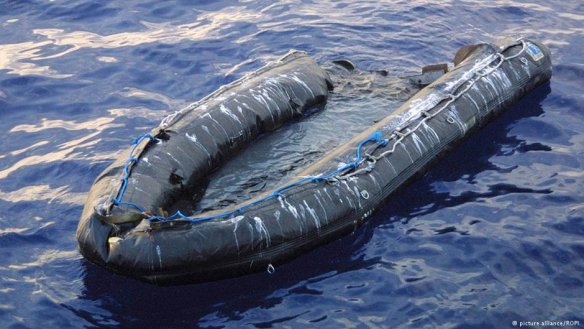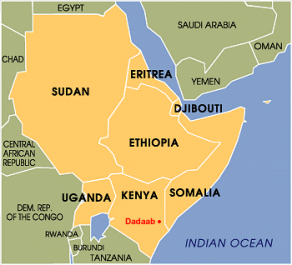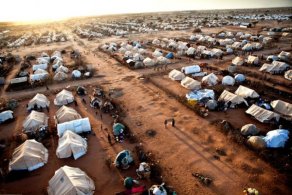The humanitarian crisis in the Mediterranean, with staggering high numbers of deaths of asylum seekers and migrants attempting to cross by sea, shows the urgency of an alternative approach to Europe’s current border policies.
Across the EU, mounting internal political pressures have intensified debates about migration and asylum, encouraging policies devised to restrict and control asylum and migration. These policies do not prevent people – many of whom originate from the Horn of Africa – from trying to cross the Mediterranean.

In 2014, Eritreans composed the second largest migrant group to Europe, after the Syrians, reaching 34,320 according to the International Organization for Migration. These figures give an indication of the ongoing and prolonged political repressions in Eritrea. Tragically, these asylum seekers often face further insecure conditions in Libya; a hub for migrants en route to the EU, and a country on the brink of state collapse.
Further southward, last week Kenya has called for the UN to close Dadaab refugee camp within three months. Dadaab is Africa’s largest refugee camp; home to an estimated 500,000 refugees from neighboring Somalia. More insecurity and a looming humanitarian disaster is predicted for the Kenya-Somalia borderlands (and beyond) if mass involuntary return of refugees is implemented.
Why do they flee?
 A complex mix of drivers compels migrants to flee from countries like Somalia, Eritrea and Ethiopia in search of security and better lives elsewhere. These motivating factors range from war and generalized violence to extreme poverty and repressive governmental policies.
A complex mix of drivers compels migrants to flee from countries like Somalia, Eritrea and Ethiopia in search of security and better lives elsewhere. These motivating factors range from war and generalized violence to extreme poverty and repressive governmental policies.
Eritrea is among the most closed countries in the world, with human rights conditions remaining dismal. Human Rights Watch has in recent years identified indefinite military service, torture, arbitrary detention, and severe restrictions on freedoms of expression, association, and religion as some of the main factors that provoke thousands of Eritreans to flee the country each month. The organization also points to the fact that Eritrean border guards operate with ‘shoot to kill orders’ against people leaving the country without permission.
Somalia collapsed into civil war in 1991. At present, the situation in large parts of south-central Somalia is still highly unstable and insecure. The Islamist group Al-Shabaab has lost control over considerable territory after a military offensive conducted by AMISOM in collaboration with the Somali National Armed Forces in 2014. But as a range of Human Rights Watch reports on Somalia illustrate, human rights abuses are common among all parties in the conflict and citizens continue to lose their lives in episodes of armed fighting. Furthermore, the random nature of attacks by Al-Shabaab in Mogadishu and other central cities in Somalia continue to make life in south-central Somalia very insecure.
Reluctant regional hosts
While thus, citizens in countries like Eritrea and Somalia continue to live in conditions of repression and insecurity, it is not only Europe that is unwilling to share the burden of hosting these refugees. On Saturday 11 April 2015, Deputy President William Ruto threatened that if the UNHCR would not close the Dadaab refugee camp and provide alternative arrangements for its residents, Kenya would take the initiative to relocate the refugees back into Somalia.

Kenya has called for the UN to close Dadaab refugee camp within three months.
The call to close Dadaab has been part of political discourse in Kenya pretty much from the time the camps were set up in 1991. This discourse has intensified greatly in recent years, as the number of attacks carried out by Al-Shabaab has increased dramatically; especially since Kenyan troops have been part of AMISOM operations inside Somalia. While previous calls have not led to major repatriations, return is now accepted by all parties – including UNHCR – as the main solution and repatriations into south-central Somalia are already on their way despite continued instability.
The international focus on stabilization in Somalia, combined with the increased risks Kenya faces to attacks from Al-Shabaab and the suspected recruitment that Al-Shabaab does in the Dadaab camps, have made Kenyan calls for return more internationally acceptable. Ruto’s latest remarks came after the 2 April terrifying attacks in Garissa, a town about 100 km from Dadaab, which hosts a population of largely Kenyan-Somalis. While preliminary investigations suggest that those responsible were in fact Kenyans of Somali ethnic background rather than Somali refugees, these brutal attacks form the backlog against the message that ‘enough is enough’ and the refugees will have to leave.
While Kenya is one of the few countries in the region that is not producing large-scale refugee movement, it is clear that the country is increasingly unwilling host and Somali refugees find less protection in Kenya than ever. A number of refugees in fact have already signed up for repatriations because of the continuously worsening conditions for refugees in Kenya. While over recent years, slow and careful improvements towards increased stability can be seen in certain areas of south-central Somalia, insecurities related to violent conflict are still rampant and the large-scale rapid return of half a million refugees risks fundamentally disrupting whatever stability has been achieved.
A burden no one wants to share
When we see the horrible pictures of the unfolding humanitarian disaster in the Mediterranean, we may want to remind ourselves of the fact that a number of the people who put their lives in danger in overcrowded boats, are people who flee conditions in countries like Eritrea and south-central Somalia and who find no protection in the countries they pass on their way to Europe – including Kenya and Libya. That might make it easier to understand the choices that people make; or rather the lack of choice they feel they have.
Unfortunately, the alternative approach that the EU has been exploring so far, through the Khartoum Process, draws on the belief that these same countries – including again Eritrea and Kenya – can provide the solution to Europe’s problems. It is however very clear that the states hosting refugees in the Horn, do follow Europe’s example and are increasingly unwilling to bear this burden; whereas those creating refugees certainly cannot be trusted to provide protection. This leaves an increasing number of people with no option but to try to cross into Europe.
- This text has also been published in Norwegian, in Dagsavisen / Nye Meninger 16 June 2015: En byrde ingen vil bære